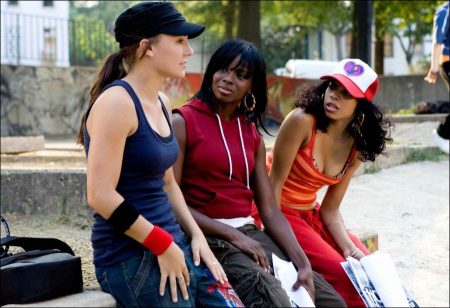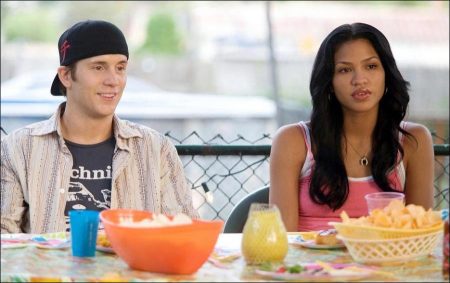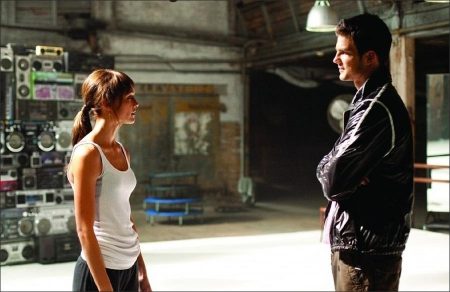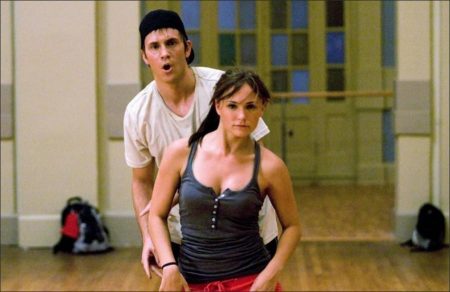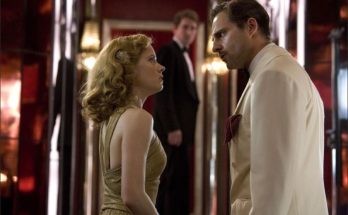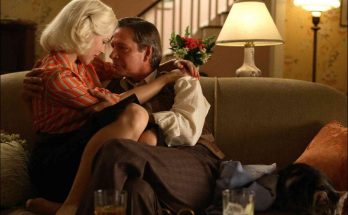Street Moves: Choreography and Design Set the Tone
From the beginning, director Jon M. Chu wanted STEP UP 2 THE STREETS to have its own distinct look and feel—one that draws from the explosive creativity and raw emotion of authentic street-dance styles. Chu knew that the film’s entire design concept would have to revolve around strong, original choreography, so he worked closely with a trio of renowned legends in the hip-hop world, who together were able to weave an astonishing array of different dance forms into the film’s gritty tapestry.
Serving as the film’s supervising choreographer is Jamal Sims, who worked with Anne Fletcher on the first “Step Up” as Channing Tatum’s choreographer and has also worked with producer Adam Shankman on such films as “Hairspray.” Among the scenes where Sims’ creative touch can be felt is the joyous and sensuous hip-hop salsa fusion that takes place at Missy’s house.
Sims was joined by Nadine “Hi Hat” Ruffin, known for breaking new ground as hip-hop’s leading female choreographer and whose tough, inventive and empowering moves for women, as well as her work on the popular videos of hit recording artist Missy Elliot, have brought something fresh and real to the genre. Hi Hat worked with the champion 410 crew, choreographing their numbers as they rise to dominance, weaving break-dance pops and locks into the mix and even using trampolines to take their moves to a higher level.
Completing the threesome is Dave Scott, a native of Compton who danced his way into a career in theater, film and television and came to the fore with the dynamic moves of “Stomp the Yard.” Scott choreographed the MSA crew’s numbers, taking them from funky misfits unsure of their style to dazzling hip-hop stars in their own right.
Sims credits the film’s cast with bringing the work of all three choreographers to life with so much zeal. “They were all so gung ho and ready to try anything,” he notes. “They’re all the real deal and they just want to dance, which made the process both a lot of fun and very true to the story.”
Hi Hat also gives respect to director Jon M. Chu. “He always knew exactly what he wanted and had every dance planned out in his head, which is a rare thing for a director,” she observes. Scott admits there was even a little healthy competitiveness between the three — which was encouraged by Chu who kept the choreographers from seeing each other’s work until the last possible moment to enhance the suspense between The 410 and MSA crews.
“The dance world is always very competitive; everybody wants to battle,” Scott explains. “Everyone wants to be better than everyone else, but if you’re good, you also give props where props are due. Hi Hat is an incredible choreographer and having her work with the rival crew was very motivating. I think we brought out the best in each other.”
Meanwhile, to highlight the kinetic feeling of the entire film, Chu also worked closely with his design team, including cinematographer Max Malkin, production designer Devorah Herbert and costume designer Luca Mosca, each of whom Chu brought on board because of their innate understanding of rhythm and style.
Malkin, in particular, had his work cut out for him, shooting on-the-fly in Baltimore warehouses and trainyards and trying to add a subtle layer of fairy-tale sheen to this often grey, grimy urban background.
“Max Malkin brought a real visual energy to the movie,” says executive producer David Nicksay. “He allowed it to feel rough around the edges and kind of restless, really capturing the emotional power we were trying to bring out of the characters and the storyline.”
“I was open to being more visually progressive than you usually see in dance films,” adds Malkin. “We didn’t want to create music videos that are separate from the story but to weave the narrative into the dance and vice versa. Jon gave me a lot of freedom to do that and was open to a lot of new and different ideas that I think make the film far more visually expressive.”
Devorah Herbert took Chu’s vision of a gritty, urban fairy tale set in Baltimore and ran with it. “We really focused on the contrast between the world of the MSA students and the dancers from the streets,” explains Herbert. “At MSA, we used a muted color palette with cool, even tones, while on the streets everything is super-textured and grimy, but with lots of splashes of color and graffiti representing the kids’ creative expression.”
The final touches were added by Italian-born costume designer Luca Mosca, who says he “fell in love at first sight with this project, with the energy, the story and the creative opportunities it gave me.” Mosca worked closely with Chu to give each of the dance crews, as well the individual dancers, their own strong, clear personalities. “The 410s I always saw as moving graffiti, dancing against these dark, earthy backgrounds in saturated primary colors,” he explains. “The MSA crew are more muted with a softer palette, but in the finale in the rain they’re in maroons and mustard yellows and burnt oranges. They come together with a beautiful harmony in a very unpredictable way.”
Robert Hoffman Is Chase
There’s no doubt about it, Chase is MSA’s star student. He’s got the charisma, the smarts and the skills to be a big-time professional performer, and he knows it. But that doesn’t mean the pressure’s off, because he doesn’t want to just be technically good; he wants to be different, he wants to stand out, he wants to find the strength to be his own person. Ultimately, he must stand up against his brother Blake, the school’s rigid, classically trained director, to change things up and restore creative freedom to the place he loves.
The filmmakers of STEP UP 2 THE STREETS knew that casting Chase would be key to forging their entire ensemble, as well as to setting off the sparks that heat things up between Chase and Andie, so, as production kicked into high gear, he was their number-one casting priority. A search led them to Robert Hoffman, who began dancing way back in kindergarten, mastering every form, from tap and ballet to jazz and all the way to hip-hop as he grew up, and much like Chase, winning all kinds of awards and competitions.
Hoffman went on to become one of the breakout stars from MTV’s hit series “Wild ‘N Out,” made his motion-picture debut in “You Got Served” and then lined up a major role in “She’s the Man,” starring with Amanda Bynes and Channing Tatum. It was clear from his audition that he was on the cusp of something big.
“Robert is just so natural and so real,” observes director Jon M. Chu. “He has that schoolboyish- charm quality to him, yet he’s also a really special dancer. I knew he was the one who could pull this role off.”
Hoffman was able to nail the character of Chase so closely, in part, because he could instantly relate to him. “Chase is the guy at MSA who has it all going for him, but the one thing he’s never had, which is actually very much a parallel in my life, is someone to tell him to believe in his own voice as a dancer, to tell him to dance how he wants to dance, from the inside,” explains the actor.
“When Andie comes to the school, it’s through her that Chase gets rejuvenated. He finds his passion for dance again. She shows him what it’s like to dance from your heart, to really be an individual, and that changes everything for him.”
He continues: “As someone who grew up as a dancer only wanting to learn from people who inspire me and then to inspire other people—the whole experience of being part of this movie has been a dream come true.”
For Jon M. Chu, Hoffman’s real magic is worked when he starts to break out and follow the beat that’s in his heart. “When you see Robert as Chase really pour it out on the floor, it becomes clear that hip-hop is an art form, and even his brother can see the art in it,” says Chu. “Robert makes that transformation happen.”
Briana Evigan Is Andie
The heart of STEP UP 2 THE STREETS is Andie, the young woman from the same tough neighborhood as “Step Up”’s Tyler Gage (Channing Tatum) who must try to find a way to transcend her troubled past and fit in at MSA, while still staying true to her roots on Baltimore’s streets. As with Chase, the filmmakers knew they would need to find someone who had both the dancing skills and the acting chops to make her journey come alive. This led them to a brand-new face: Briana Evigan, who at the age of 7 started dancing with hip-hop choreographer Shane Sparks (television’s “So You Think You Can Dance?”) and has gone on to appear in several music videos and independent films.
It was when Evigan first read with Robert Hoffman—and the temperature in the room soared—that the filmmakers were sold that she was their Andie. “When they read together, it was magic,” recalls Chu. “Briana came alive, and she and Robert fed off each other’s energy just as we hoped.”
Adds David Nicksay, “Briana brought a deep, soulful quality to Andie. She comes off as very authentic, organic and moving. She’s also incredibly funny and a smashing dancer.”
Evigan, too, was grabbed by the strong affinity between her own struggles as a young actress and dancer and those of her character. “Andie might start the film having lost a lot, but she’s got a goal and dream and she’s not going to let anything get in her way,” Evigan says.
“Her mother has died, she has no father figure, and she’s a little unsure about men. But slowly she learns that sometimes you have to put some things aside to let what you want really come to you. By the end, she falls in love with the guy she’s been pushing away the whole time, and she learns about the importance of not only belief but of respect.”
When it came to the demands of the dancing, Evigan took a new approach — trying to emulate the strength and fury of street dancers. “I had to drop the whole sexy thing that I had developed and break away from that for a more hard-core approach,” she explains. “It was challenging, but I loved it and learned so much. I also loved the way the members of the dance crews each had such strong personalities so that the dancers and their personal relationships stand out much more than they do in other dance movies I’ve seen.”
Most of all, Evigan was inspired throughout by Andie’s unbreakable spirit, which brings her to a place she never expected. Sums up the actress: “When times are really tough and everything is falling apart and you feel like you don’t belong anywhere, Andie shows that you just need to stay strong and keep going and never let anyone step in the way of your dream.”
Cassie Ventura Is Sophie
When Andie arrives at MSA, she finds herself in a rivalry with one of the school’s most promising and confident female talents: the “triple threat” actor, singer and dancer, Sophie, who also happens to be Chase’s jealous ex-girlfriend. For this key role, the filmmakers chose another newcomer to the screen, Cassie Ventura, the R&B recording artist who makes her feature-film debut and also contributes a song to the soundtrack.
Although, like her character, Cassie is a natural singer, she turned out to be the only member of the astonishingly accomplished cast who had no real dancing experience. But this turned out to be only a minor hitch for Cassie, who honed her natural talent in intensive rehearsals. “I think I was the only untrained dancer in the production,” she admits, “but I knew that if I put my heart into it, people would feel that—and so I just went for it.”
Jon M. Chu was impressed with not only Cassie’s bravery in jumping into the role but with her strong presence that captures Sophie’s intensity and fury. “When Cassie walks into a room, right away it feels like she really owns the space,” he notes. “And I think she really enjoyed playing a kind of bad-guy role, because she herself is so sweet. She also really understood that Sophie has her own arc in the story. She’s not really a villain because, deep down, she’s a lost soul, too, and eventually she is pushed into doing something nice for the first time in her life.”
Cassie loved taking Sophie through major internal changes, from self-centeredness to seeing the bigger picture. “In the beginning of the story, Sophie is a very strong-willed, focused girl, almost like a machine,” she observes. “She has shut down her emotions, but her relationship with Andie forces her to rediscover her feelings and the importance of other people.”
Meet the Dance Crews: The 410
Andie might find herself dancing in the rarified world of the Maryland School of the Arts, but her heart is back in the streets with the legendary underground Baltimore street crew she has long dreamed of dancing with: The 410. This ragtag crew is made up of a group of strong, flashy personalities whose completely original skills and hard-core passion for hip-hop make them among the city’s most creative and coolest dance teams—and the ones to beat at “The Streets” competition.
Casting the members of The 410, as well as the rival MSA crew, was a blast for the filmmakers because it gave them a chance to witness some of the amazingly diverse and magnetic dancing talent out there today. The audition process began with massive open calls in Baltimore and New York, during which 500 hopeful dancers were whittled down to just a handful of stand-outs under the demanding eyes of the filmmakers and the choreographers.
Authenticity was at the heart of every decision—the focus on dancers who could relate to the material with their hearts as well as their skills. The uncompromising leader of The 410 is Tuck, the intense street dancer who has his own feelings for Andie that get shaken up in the mix. For Tuck, The 410 is more than just a dance crew—it’s a kind of street family who stick together through thick and thin, and Andie’s departure to attend MSA, or what he dubs “that prissy ballet school” leaves him feeling both betrayed and jealous.
Playing Tuck is Black Thomas, a Miami native who cut his teeth as a dancer in the FAMU Connection, a hip-hop dance troupe at Florida A&M University, then went on to appear in such movies as “Stomp the Yard,” “Dreamgirls” and “I Now Pronounce You Chuck and Larry.”
Like the rest of the cast, Thomas felt a deep empathy for his character and his love of dancing in spite of his emotional confusion over Andie. “What I liked most is that this movie says a lot about how you view yourself, how you represent,” says Thomas. “The 410 is all about attitude. It’s all about unity. It’s all about strength and power. It’s not just about kids dancing, it’s about kids expressing themselves.”
The filmmakers were impressed with Thomas’ ability to evoke Tuck’s strength and belief through both his dance moves and his dialogue. “As Tuck, Black has the power to be at once vulnerable and scary,” notes Chu. “We wanted the audience to feel the friction and the threat of the character, and Black had it all. Plus, he’s an amazing dancer.”
The 410 crew’s female leader and Andie’s former best friend, Felicia, was equally vital to the story and the filmmakers found themselves drawn to Telisha Shaw, a rising young dancer who herself received a sought-after scholarship to the Dance Theatre of Harlem that kicked off her career dancing on tour with such artists as Christina Aguilera, Janet Jackson, Green Day, Kanye West and Beyonce.
A playful chorus of “Telisha plays Felicia” echoed throughout the production, but the filmmakers were very pleased with the serious work Shaw brought to the performance. “Felicia is such a hard role,” says Chu, “because she’s Andie’s friend in the beginning, then turns on her quickly, only to come around again at the end. When Telisha came in, she read the scene where she tells Andie, ‘It’s not what you want, it’s what you got’ — and she turned it into one of the most memorable auditions I’ve ever been in. She read it in a way that I’d never even imagined that scene, in a way that made me want to cry for her. Telisha portrayed the character as someone who wants to believe in Andie, but everything in her life has shown her something different. She has to come to realize that the way you live your life is a choice you make.”
Also joining The 410 are a number of young stars from authentic hip-hop backgrounds who bring their own trademark tricks, moves, humor and style to the proceedings: Kejamel “KMel” Howell, a dance legend on YouTube and MySpace who also serves as Hi Hat’s assistant choreographer, is K-Mel; Rynan “Rainen” Paquio, who is part of the renowned Jabbawockeez crew, is Kid Rainen; local Baltimore b-boys Jeff “Rapid” Ogle and James “Cricket” Colter are Rapid and Cricket; Donnie “Crumbs” Counts, a world-class athlete and dancer with hundreds of popular videos on the Internet, is Crumbs; and acclaimed b-girls Shorty Welch and Alison Faulk are Shorty and Alstar.
Danielle Polanco, a Bronx native who began dancing at the Alvin Ailey School as a youngster and was on tour with Jennifer Lopez when she was cast in the film, rounds out The 410 crew as Missy, who brings a salsa touch to her dancing and is the only other person who dances with both The 410 and MSA crew. She, too, found herself deeply relating to what her character goes through in the film.
Says Danielle: “Missy is the kind of person who tries to make the best out of everything. When everybody else is arguing, Missy just enjoys life and looks at the boys. Jon lets us all ad lib and add a little of our own flavors to the character, and that made it so much fun.”
Step Up 2: The Streets (2008)
Directed by: Jon Chu
Starring: Briana Evigan, Robert Hoffman, Cassie Ventura, Will Kemp, Danielle Polanco, Mari Koda, Luis Rosado, Telisha Shaw, Black Thomas, Janelle Cambridge, Adam G. Sevani
Screenplay by: Toni Ann Johnson, Karen Barna
Production Design by: Devorah Herbert
Cinematography by: Max Malkin
Film Editing by: Andrew Marcus
Costume Design by: Luca Mosca
Set Decoration by: Jennifer M. Gentile
Art Direction by: Paul D. Kelly
Music by: Aaron Zigman
MPAA Rating: PG-13 for brief violence, language, some suggestive material.
Distributed by: Buena Vista Pictures
Visits: 148
